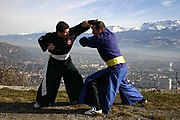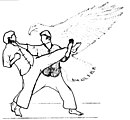Bando
This article includes a list of general references, but it lacks sufficient corresponding inline citations. (May 2010) |
 | |
| Also known as | Bando thaing |
|---|---|
| Country of origin | |
| Famous practitioners | Pye Thein, Maung Gyi |
| Olympic sport | no |
Bando (Burmese: ဗန်တို, pronounced [bàɴdò]) is a defensive style of thaing focusing on animal-based techniques. The earliest meanings of the word were self-discipline, self-development and self-improvement.[citation needed] Later, it came to mean self-protection or self-defense. Bando is sometimes mistakenly used as a generic word for all Burmese martial arts but it is actually just one system.
Training

As with most Asian martial arts, all bando schools start off by teaching the basic stances and footwork. This preliminary stage of training lasts for several months and in some cases the first stage may continue for years, depending on the instructor or the style.[citation needed] In the second stage of training, a series of blocking and parrying techniques is taught. Bando prioritises defense over offense so that the student will be able to protect themselves, should the need arise. The third stage involves the learning of offensive techniques. Most of bando's techniques are taught through forms or aka which may be performed solo or with a partner. The final stage of mastery includes participation in contests, which sometimes end in deaths.
Techniques

Forms and techniques in bando are based on the movements of animals, probably through the influence of animal styles from India and China. Such routines include the boar, bull, cobra, leopard (or panther), monkey, python, scorpion, tiger, deer, paddy bird, and viper. The moves in each pattern are characterised by the animal which they imitate. Thus the python form includes crushing, strangling and gripping moves, the tiger form involves clawing and ripping, the viper form stresses flexibility while the deer form develops alertness. Some masters teach the black panther style as a combination of all the other animal forms.
Bando generally leaves the initiative to the opponent and relies heavily on countering maneuvers. When a bando exponent is attacked, they first withdraw and then begin the counter-attack. "Middle-style bando" is perceptive/responsive. Once the threat has been evaluated it is possible to respond with an appropriate counter, so too is destroying the opponent's weapon. If the adversary's hand or foot is broken for example, the conflict is effectively ended. Bando practitioners generally aim for the body but the head, shoulder, elbow, knee, and foot are all used for offensive purposes.
The International Bando Association

After WWII, Ba Than (Gyi), then director of physical education and athletics for the Union of Burma, tried to unite the techniques from the different bando styles and modernize them by founding a new Hanthawaddy bando system. The International Bando Association was officially formed on March 9, 1946. Donn F. Draeger describes the organisation's founding as follows:
In 1933 the Military Athletic Club was formed at Maymyo in northern Burma by Gurkha Officers. By the end of the decade the club included Chin, Burmese, Kachin and Karen army officers. G. Bahadur, a Gurkha, was elected the first chairman of the club. Another luminary was Ba Than (Gyi) who was to serve twenty five years as Director of Physical Education of Burma before retiring. ...the International Bando Association, was established recently by Ba Than (Gyi) in memory of those who died in the China-Burma-India area for the allied cause in World War II. As such, it continues the work of the Military Athletic Club, which lapsed in 1948. It has of course a more international character, and Maung Gyi, its teacher accredited to the United States, is the son of Ba Than (Gyi). Maung Gyi a versatile fighter in his own right, having studied Chinese, Indian, Japanese and Western methods.[1]
Currently the federation acknowledged that organizes Bando Thaing globally is the International Thaing Association Bando is the inheritor of the International Thaing Association which was established in 1997 in Yangon in Myanmar. The ITBA aims to bring together all the different styles of martial arts and combat sports of Myanmar under the same flag with the same values ...
It is administered on the final international of all forms of teaching and promoting "Thaing," the "BANDO" and all of martial arts and fighting the current Myanmar (formerly Burma).
Contribute to the improvement of teaching and promoting Thaing and its components:
The Bando, self-defense (codified in animal form); Banshay, the traditional weapons (spear, sword, dagger, bow, long and short stick, ...); the Naban, the Naban, traditional wrestling; the Lethwei, Myanmar traditional boxing and its variations (Bando kickboxing, Lethwei controlled ...); Forms and internal energy (Letha Yoga Dandha yoga, yoga longyi; Nin Zin). Its headquarters are in Lausanne in Switzerland and its current president since March 9, 2009 is the Spanish Jesus Vazquez Rivera
Bando in the U.S.

Maung Gyi (born in 1936 or 1934), the son of Ba Than Gyi, began formally teaching bando in the 1960s in Washington, D.C. His Hanthawaddy style of bando is today the most popular Burmese martial art in the Occident.
The American Bando Association incorporates nine animal styles including the bull, boar, cobra, viper, python, panther, tiger, scorpion and eagle. Students first learn the basics of bando before advancing to the animal techniques. The basis for the ABA's bando system is a 9X9 matrix of techniques and principles. The student is encouraged to grasp the underlying principles of the art, as one technique may only be useful in a certain situation, but the principle the technique is built on will be useful in many situations.
Aside from bando, the association also teaches banshay, lethwei and naban. Students advance in rank through a set of coloured belts, a practice adopted from judo. This generally consists of the white, green, brown and black belts but some schools also include yellow as an advanced white belt. A student may only test for their black belt after at least five years of training. To advance to this stage, the student must exhibit proficiency in aka (empty-handed forms), stick weapons, bladed weapons, sparring, and pass a physical fitness test.
list of belts white, yellow, orange, purple, blue, green, 1st degree green, 2nd degree green, 3rd degree green, brown, 1st degree brown, 2nd degree brown, 3rd degree brown, black, 1st degree black, 2nd degree black, 3rd degree black, 4th degree black, 5th degree black, 6th degree black, 7th degree black, 8th degree black, 9th degree black.
See also
- Burmese martial arts or Thaing (burmese)
- Banshay
- Lethwei
- Naban
- Pongyi thaing
- Bando yoga
- Bokator
- Kuttu Varisai
- Silat
References
- ^ Donn F. Draeger and Robert W. Smith (1969). Comprehensive Asian Fighting Arts. Kodansha. ISBN 978-0-87011-436-6.
 Ba Than (Gyi), Manual of the Bando discipline, National Bando Association, Burma, 1946–68
Ba Than (Gyi), Manual of the Bando discipline, National Bando Association, Burma, 1946–68 Maung Gyi, Bando, philosophy, principles et practice, IST edition, 2000
Maung Gyi, Bando, philosophy, principles et practice, IST edition, 2000 Maung Gyi, Burmese bando boxing, Ed. R.Maxwell, Baltimore, 1978
Maung Gyi, Burmese bando boxing, Ed. R.Maxwell, Baltimore, 1978
External links
- International Thaing Bando Association
- French Bando & Lethwei Federation
- Meylan Thaing Bando
- Grenoble Thaing Bando
- Pakistan Bando karate Association International
- The 1st biggest blog of the Karate Association
- American Bando Association & More Info (Greater Hartford Bando Association page)
- Advanced Fighting System
- Bando of New England
- Northern Virginia Bando Club
- Piedmont Bando Club, Northern Virginia
- Combat Bando Association
